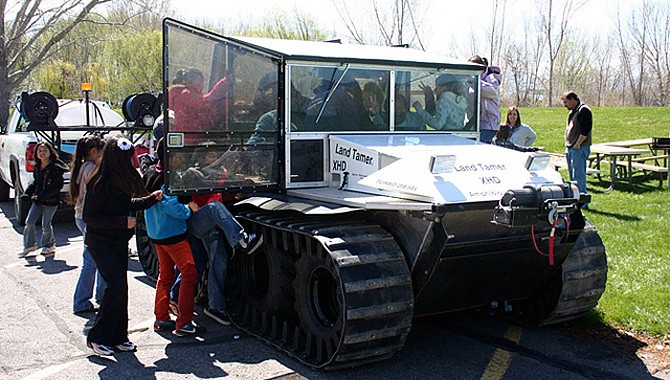PF Manufacturing out of Montana is mostly in the business of making mine sweepers—mini tanks used by the military to sniff out bombs. But the manufacturer recently sold one of their custom “land tamers” to Utah County and the Utah Lake Commission to sniff out another kind of problem.
The invasive phragmites weed.
Used in tandem with aerial sprays, the modified land tamer is helping local officials rid Utah Lake of some 7,000 acres of phragmites around the shoreline (affected areas here). But the work ain’t easy and it takes a lot of time.
“Phragmites removal is a three year process,” says Aaron Eagar, Utah County Weed Supervisor. “In the first year, we spray herbicide on the infected area in August and September, before the first hard freeze. Then we smash the phragmites several times over (video below) instead of burning.”
While controlled burning is the most effective way of ridding the dead phragmites, Eagar says it’s not conducive to Utah Lake’s sensitive and complex environment. So officials have decided to smash instead of burn.
In the second year, Eagar and his team then evaluate the initial progress and also start removing other invasive weeds, including tamarisk and Russian olive. “With the help of the land tamer, we have a 85-90% success rate in removing phragmites,” he says.
But it doesn’t take a mathematician to know that 10-15% inevitably “pop back up,” as Eagar puts it. In that case, the land tamer is used amphibiously to reach hard-to-get or otherwise resilient phragmites. In addition to planting naturally occurring plants to ensure others don’t come back, Eagar spends much of year three finalizing the shoreline restoration.
“The project requires about 40% of our annual time,” Eagar says, the bulk of which takes place exclusively during winter months. During the summer, most of the phragmites work is spent monitoring progress and planning for the next round of spray, smashing, and replanting.
But not only is the land tamer key in accelerating the biodegradation process and reaching submerged phragmites, it helps officials access residential, recreational, and other sensitive areas to create a buffer for wider coverage ariel sprays.
That said, the entire project will take more than a decade to complete, at least at the current rate of restoration, including resources and manpower limitation. “The initial timeline attempted to do all 7,000 affected acres within 12 years,” Eagar says. “Unfortunately, we’re not going to be able to achieve that; it will probably require more like 14 years.”
Still, the land tamer “has dramatically improved what we can accomplish,” suggesting that without it, the project might have suffered further delays in the overall timeline.
As for the chemical—always an understandble concern to residents, Eagar had this to say:
“State and local officials have extensively evaluated the effect of the chemical so it doesn’t hurt wildlife and residents, including amounts and frequency that we use it. In fact, there are more effective chemicals that are a little more harsh, so the commission and all involved decided to use the safest chemical available.”
Video of land tamer in action
[youtube]http://www.youtube.com/watch?v=vv14to3J4NE[/youtube]
See also

